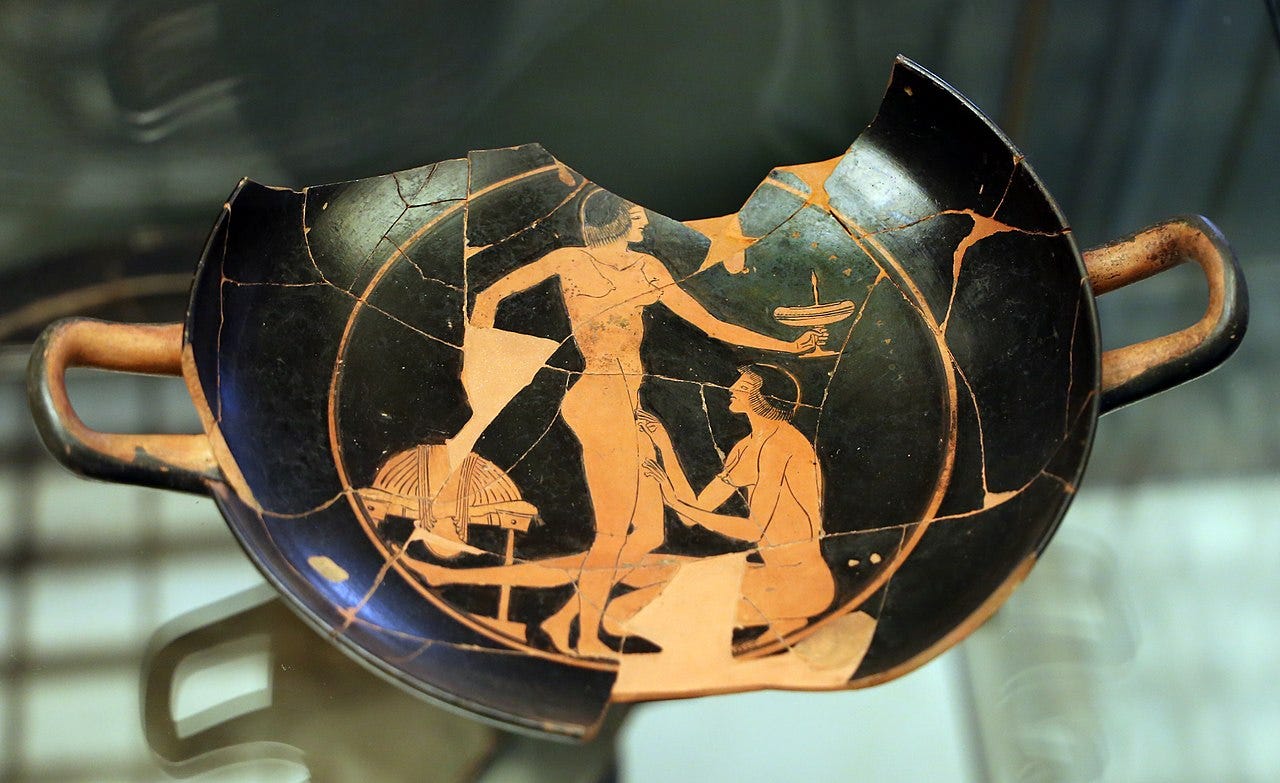Touch Thyself, Heal Thyself - In Honor of M*sturbation May
The Sacred (and Scientific) Power of Self-Pleasure
May I interest you in a little self-reflection? A little touch of joy? A finger-trace of permission across your own skin?
Welcome to Masturbation May, where I unapologetically dive into the pleasure principle—not as a naughty secret or last resort, but as a vital, vibrant act of self-care, nervous system regulation, and intimacy.
Let’s be clear from the start: masturbation is not just about orgasm. It’s about connection. To oneself, to another (if done together), and to the emotional and physiological benefits that ripple far beyond a few moments of ecstasy. So, for the next few scrolls, join me in peeling back the cultural shame, the medical jargon, and the societal hush-hush, and let’s explore why touching yourself might be one of the healthiest things you can do this May—and every month after.
The Science of Solo Pleasure: Your Brain on Masturbation
Masturbation activates a glorious cocktail of neurotransmitters. Think of it as a personal pharmacy—your body dispensing feel-good chemicals with every breathy sigh.
When you orgasm (or even when you build toward one), your body floods with:
Dopamine – The “reward” neurotransmitter, giving you that euphoric, almost triumphant high.
Oxytocin – Often dubbed the “cuddle hormone,” it fosters feelings of safety, connection, and trust—even when you're solo.
Endorphins – Natural painkillers that reduce stress, elevate mood, and sometimes even help with period cramps or migraines.
Prolactin – Released post-orgasm, it contributes to that post-climax blissed-out calm.
Regularly engaging in masturbation can help regulate mood, manage stress, reduce anxiety, and in some cases, alleviate mild depressive symptoms. A 2009 study published in The Journal of Sexual Medicine found that orgasms—whether achieved with a partner or alone—correlated with improved psychological well-being, better sleep, and reduced cortisol levels. In other words: touching yourself may literally help you chill out.
Think of it as a neurological spa appointment with no commute.
Know Thyself: Masturbation as Embodied Self-Awareness
In the realm of sexology and somatic therapy, we often speak of interoception—the ability to sense what's happening inside your body. Masturbation can be a profound tool for developing this.
When you masturbate with intention (not just as a sleep aid or stress release), you begin to map your own pleasure geography. What textures, speeds, pressures, or rhythms feel best? What moods evoke arousal? Where does arousal live in your body—your thighs, chest, stomach, jaw?
This self-knowledge becomes especially empowering in partnered sex. If you don’t know what you like, how can someone else? But if you do—oh, honey, the menu you can offer is exquisite.
Some researchers refer to this as “erotic intelligence”—the ability to understand, articulate, and navigate one’s sexual needs and boundaries. Masturbation is often the first classroom in that curriculum.
Mutual Masturbation: The Erotic Art of Being Seen
Let’s dispel a myth: masturbation isn’t just a solo sport. Enter the sensual symphony of mutual masturbation—watching, being watched, pleasuring yourself while your partner does the same, or even pleasuring each other without penetration.
This can be:
A beautiful alternative for long-distance lovers (hello, video calls).
A way to connect during periods, postpartum healing, or other times when penetration isn’t ideal.
A way to share fantasies, pacing, and preferences without the pressure of performance.
In fact, mutual masturbation builds emotional intimacy. You’re inviting someone to witness your pleasure practice—a sacred thing, especially in a world that so often treats self-pleasure as something to hide.
Psychologist and sex therapist Dr. Emily Nagoski often discusses how arousal is context-dependent. Watching your partner experience genuine pleasure (or allowing them to witness yours) creates a powerful context of safety, connection, and erotic vulnerability. It’s intimacy without obligation, arousal without acrobatics.
And yes, the same feel-good neurochemicals apply—only now, they’re amplified by the shared energy in the room.
Body Literacy: How Masturbation Teaches You to Listen
For those who have experienced trauma, chronic illness, or long-standing body shame, masturbation can become a reclamation practice. It says: I deserve to feel good in this body. I am allowed to touch myself with curiosity and kindness.
Touch can bring you back into your skin after disassociation. It can help you reframe your body not as something broken or to be fixed, but as capable of joy, even if it’s in small, slow ways.
Some people report increased confidence from regular masturbation. Not from ego—but embodiment. They walk differently. They dress in ways that reflect how they feel, not how they’re told to look. They become fluent in the language of their own desire, and that confidence—let’s be honest—is hot as hell.
Orgasm as Medicine: Mental, Physical, Emotional
Still not convinced that masturbation is a wellness practice? Let’s break it down by benefit:
🧠 Mental Health
Reduces cortisol (the stress hormone)
Increases serotonin and dopamine
Improves sleep (thanks to prolactin and oxytocin)
Enhances focus and reduces brain fog in some cases
💪 Physical Health
Boosts immunity (orgasms may increase immunoglobulin A)
Relieves menstrual cramps
Improves pelvic floor strength when paired with kegels or breathwork
May reduce risk of prostate cancer (in men) according to some longitudinal studies
❤️ Emotional Regulation
Helps process shame around sexuality
Fosters acceptance of changing bodies, especially in aging or postpartum phases
Provides a safe outlet for erotic fantasy and stress release
The Gender Gap in Masturbation
Let’s talk stats. Surveys consistently show a masturbation gap: men report higher frequencies of masturbation than women or femme-aligned folks. But this isn’t because women aren’t interested. It’s often cultural.
Shame. Silence. Lack of access to pleasure education. Genital anatomy shrouded in mystery. Genitals in anatomy books often skew male by default. Sex ed skips clitorises almost entirely. It’s a systemic blind spot.
But that’s changing.
Thanks to sex educators, content creators (hello, that’s me), feminist porn, and movements like Masturbation May, we’re seeing more people AFAB (assigned female at birth) exploring their pleasure with curiosity and pride.
The more we normalize this exploration, the more everyone benefits.
Getting Started (or Re-started): Tips for a More Fulfilling Masturbation Practice
Whether you're brand new to exploring your own pleasure or just want to upgrade the vibe, here are some gentle, sexy suggestions:
1. Create an Environment of Invitation
Set the mood: dim lights, candles, music, cozy blanket.
Try touching your body without expectation. Let it be sensual, not goal-oriented.
2. Try New Tools
Explore different lubricants (flavored, warming, water-based, silicone).
Invest in a toy: clitoral vibes, strokers, wands, or suction toys. Mutual masturbation? Share your faves!
3. Play With Fantasy
Read erotica or listen to erotic audio (you know where to find mine).
Fantasize freely—no shame. Imagination is your domain.
4. Use Your Breath
Slow, intentional breathing heightens arousal and deepens sensation.
Try syncing breath to movement or sound.
5. Talk to Yourself (Literally)
Yes, dirty talk. Even alone. Affirmations too. Tell yourself you’re sexy. Call yourself daddy. Whisper your favorite praise. Erotic self-talk = major turn-on.

Cultural History of Masturbation: From Taboo to Triumph
It’s worth noting: masturbation hasn’t always been so demonized. In Ancient Greece, it was considered a natural and even necessary act. Some indigenous traditions viewed sexual self-touch as a form of spiritual cleansing or energy cultivation. In Taoist sexual practices, it was a way of mastering and circulating qi (life force energy).
In fact, according to History Extra,
“Other ancient civilisations celebrated masturbation too. For example, a clay figurine of the 4th millennium BC from Malta shows a woman masturbating. In ancient Sumer [the first ancient urban civilization in the historical region of southern Mesopotamia, modern-day southern Iraq] masturbation – either solitary or with a partner – was thought to enhance potency. In ancient Egypt male masturbation when performed by a god was considered a creative or magical act: Atum was said to have created the universe by masturbating, and the ebb and flow of the Nile was attributed to the frequency of his ejaculations. Egyptian Pharaohs were required to masturbate ceremonially into the Nile.”
Then came colonialism, religious dogma, and Victorian hand-wringing. By the 18th and 19th centuries, masturbation was blamed for everything from blindness to madness. (Spoiler alert: it does neither.)
Dr. John Harvey Kellogg, yes—the Corn Flakes guy—was so anti-masturbation that he developed bland foods to dampen libido.
Thankfully, we’ve evolved. The Kinsey Reports (1940s-50s), feminist movements, and contemporary sex-positive education have all helped reframe masturbation as health, not heresy.
Final Stroke (ahem): Your Body Is Worthy of Pleasure
Masturbation isn’t a substitute for intimacy. It is intimacy. With yourself. With your fantasies. With your own electric hum of aliveness.
Whether you’re doing it to wind down, tune in, reconnect with your body after trauma, share a moment with a lover, or just because it feels damn good—self-pleasure is powerful.
So, this May, I invite you to make space for sacred seduction.
Light a candle. Slip into bed. Let your fingers find their way.
And remember: every orgasm is a protest against shame. A reclaiming of your own joy. A love letter to the body you live in.
P.S. If you enjoyed this piece, you might also love:
My upcoming erotic audio “MAY I?” (dropping this month on Patreon and my After Hours audio-only site)
A new sensually spicy photoset on my Secret Diary
Pleasure is power, darling. How will you wield yours?
Connect With Me! 🦋
Follow me on Threads, my educational Instagram , spicer Instagram, ultra spicy Twitter, and Bluesky
That Lit Witch - Cosplay and Behind the Scenes YouTube
Support my Work
Support comes in many ways. Whether you subscribe to Artistic Edge Magazine, Ink & Lavender: Tiffany's Secret Diary, Patreon, or one of my spicy sites, your contribution is beyond appreciated! Without supporters like you, I wouldn’t be able to continue writing, creating content, or hell, put food on the table. Thank you for your kindness and support!
Don’t forget! Your support comes with perks! From unlocking uncensored content to special podcast episodes, you get something special with each, including voting power for upcoming articles and cosplays, previews of public content, and exclusive lives!









